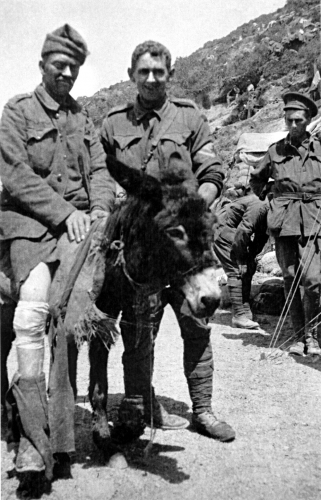Horsezone News
The Man with the Donkey - Lest We Forget
 It's about time! Finally, Private John Simpson Kirkpatrick, better known as 'the man with the donkey' from the Gallipoli campaign - whose young life was ended by a Turkish bullet, during one of his journeys up Monash Valley to retrieve wounded men - is being considered by The Defence Honours and Awards Appeals Tribunal for 'the Victoria Cross, the Victoria Cross for Australia or other forms of appropriate recognition for gallantry or valour.'
It's about time! Finally, Private John Simpson Kirkpatrick, better known as 'the man with the donkey' from the Gallipoli campaign - whose young life was ended by a Turkish bullet, during one of his journeys up Monash Valley to retrieve wounded men - is being considered by The Defence Honours and Awards Appeals Tribunal for 'the Victoria Cross, the Victoria Cross for Australia or other forms of appropriate recognition for gallantry or valour.'
With Anzac day approaching it's appropriate to think of all the equine heroes of past wars and their human partners, who lost their lives fighting for our country.
Simpson, a stretcher bearer whose brief life ended early in the Gallipoli campaign, is one of the AIF's most well-known figures, however, Simpson was - like many of his comrades - an Englishman. Born on 6 July 1892 at Shields in County Durham, he joined the merchant marine at the age of 17 and began a life of wandering that eventually led him to Australia.
The Australian War Memorial website reports that Simpson tried his hand at all manner of jobs. He carried a swag, worked as a cane cutter, a ship's hand and a coalminer, experiencing life in many parts of Australia. However distant from his mother and sister, Simpson made sure that they received a generous percentage of whatever pay he was able to earn. On 25 August 1914, shortly after the First World War began, he enlisted in the AIF and began training at Blackboy Hill camp near Perth. His motivation for enlisting, it appears, had more to do with the prospect of returning to England than with any particular desire to be a soldier.
Like many who shared his reason for joining, Simpson was disappointed when the first Australian soldiers bound for the war were disembarked for training in Egypt. Having been posted to the 3rd Field Ambulance, he was among those who landed at Gallipoli on 25 April 1915. Though a stretcher bearer, Simpson decided his task could be better accomplished using a donkey to carry his wounded charges.
Just three weeks after the landing Simpson was killed. Widely believed to have already achieved a measure of fame during his brief time at the front, it now appears more likely that the Simpson legend only grew after his death. Peter Cochrane, in his 1992 book 'Simpson and the Donkey', outlines the way in which Simpson's story was used for a range of propaganda and political purposes, particularly as manpower crises threatened to undermine the AIF's fighting ability during the war.
Cochrane, having demonstrated the extent to which embellishment and sometimes outright falsehoods have served to obscure the real Simpson, described a man who was as flawed as any other, but whose bravery is not disputed. He remains, nevertheless, one of the most famous of the men who served at Anzac.
Simpson is commemorated in paintings and with a prominent bronze sculpture at the Australian War Memorial in Canberra and now it seems appropriate that he is being considered for a Victoria Cross. Wouldn't it be lovely if there was a similar award for his brave little donkey?
News Search
Categories
- General
- Event Results
- Stallionzone
- Sponsored Shows
- Clubs
- Health
- Feature Horses
- Competitions
- Five Minutes With Horsezone
- Young Riders
- Reviews
- Training and Clinics
- Postcards from the saddle
- 2014 Equitana by HORSE FIRST
- 2013 Equitana
- 2012 Equitana
- 2012 London
- 2011 Equitana
- 2011 Queensland Floods
- 2010 WEG
